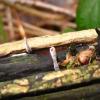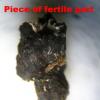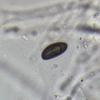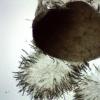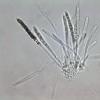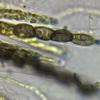
24-12-2025 17:08
Hulda Caroline HolteHello, I have found this propoloid ascomycete on

21-12-2025 09:32
Hello.A tiny ascomycete found embedded in wood in

21-12-2025 21:32
Pol DebaenstHello, Garden, Burgweg 19, Veurne, BelgiumOn 10/1

22-12-2025 23:38
Patrice TANCHAUDBonsoir, récolte sur un mur en pierre, apothéci

22-12-2025 00:47
Patrice TANCHAUDBonsoir, récolte à proximité du milieu dunaire
is this Xylaria arbusula?
François Bartholomeeusen,
27-01-2017 18:36
Found on a fallen branch of oak. The wood is colored black and the stromata has a stipe of 8x1 mm and a fertile part of 11x2.5 mm. The outer crust is hard and black with grey patches and lumpy as a result of the underlying perithecia.
TELEMORPHE:
Perithecia: subglobose 514 x 400 µm
Asci: cylindrical 124-158 x 8-9,65 µm
Paraphyses: filiform
Spores: 11,35-13,37 x 5,14-5,94 µm Q= 2.23 with straight germsplit (spore lenght 11.2 µm with germsplit length 7.85 µm)
ANAMORPHE: flat length 5-8 mm; conidia:10,41-16,3 x 3,02-3,86 µm
Macroscopic/microscopic this frb looks like Xylaria arbusula except the length of the asci is wrong and I found it in Belgium/Turnhout in winter! Is this not a tropical asco?
I will be grateful for your help!
Greetings,
François Bartholomeeusen
Jacques Fournier,
27-01-2017 21:53

Re : is this Xylaria arbusula?
Hi François,
your images do not allow an identification.
Before considering X. arbuscula you should rule out X. hypoxylon. The key feature distinguish them is the thickness and texture of the outer crust. See my notes in the monographic keys available on Ascofrance.
Good luck,
Jacques
your images do not allow an identification.
Before considering X. arbuscula you should rule out X. hypoxylon. The key feature distinguish them is the thickness and texture of the outer crust. See my notes in the monographic keys available on Ascofrance.
Good luck,
Jacques
François Bartholomeeusen,
28-01-2017 10:36
Re : is this Xylaria arbusula?
Thanks Jacques,
I have made the wrong choice at step 2 of your superb key. I chose "Stromata hard-textured with a carbonaceous outer crust".
Perhaps the persistent, drying east wind, the sun and the freezing temperature changed the texture a bit? In all cases reading your notes has shed light on my problems. I have also measured the out crust and is was about 40-45 µm thick.
Thank you for your quick reaction!
Cordial greetings,
François
